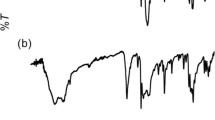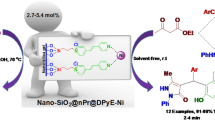Abstract
The complexes Pt(nb)3-n(P-iPr3)n (n=1, 2, nb=bicyclo[2.2.1]hept-2-ene), prepared in situ from Pt(nb)3, are useful reagents for addition of Pt(P-iPr3)n fragments to saturated triruthenium clusters. The complexes Ru3Pt(CO)11(P-iPr3)2 (1), Ru3Pt(μ-H)(μ3-η3-MeCCHCMe)(CO)9(P-iPr3) (2), Ru3Pt(μ3-η2-PhCCPh)(CO)10(P-iPr3) (3), Ru3Pt(μ-H)(μ4-N)(CO)10(P-iPr3) (4) and Ru3Pt(μ-H)(μ4-η2-NO)(CO)10(P-iPr3) (5) have been prepared in this fashion. All complexes have been characterized spectroscopically and by single crystal X-ray determinations. Clusters 1–3 all have 60 cluster valence electrons (CVE) but exhibit differing metal skeletal geometries. Cluster 1 exhibits a planar-rhomboidal metal skeleton with 5 metal–metal bonds and with minor disorder in the metal atoms. Cluster 2 has a distorted tetrahedral metal arrangement, while cluster 3 has a butterfly framework (butterfly angle=118.93(2)°). Clusters 4 and 5 posseses 62 CVE and spiked triangular metal frameworks. Cluster 4 contains a μ4-nitrido ligand, while cluster 5 has a highly unusual μ4-η2-nitrosyl ligand with a very long nitrosyl N–O distance of 1.366(5) Å.
Similar content being viewed by others
REFERENCES
D. M. P. Mingos and R. W. M. Wardle (1985). Transit. Met. Chem. 10, 441.
L. J. Farrugia (1990). Adv. Organomet. Chem. 31, 301. (b) L. J. Farrugia, in E. W. Abel, F. G. A. Stone, and G. Wilkinson (eds.), Comprehensive Organometallic Chemistry II, Vol. 10 (Pergamon, Oxford, 1995), pp. 197–254.
D. M. P. Mingos (1984). Acc. Chem. Res. 17, 311. (b) S. M. Owen (1988). Polyhedron 7, 253. (c) D. M. P. Mingos, in D. F. Shriver, H. D. Kaesz, and R. D. Adams (eds.), The Chemistry of Metal Cluster Complexes (VCH, Weinheim, 1990), pp. 11–119.
R. D. Adams, in D. F. Shriver, H. D. Kaesz, and R. D. Adams (eds.), The Chemistry of Metal Cluster Complexes (VCH, Weinheim, 1990), pp. 121–200.
D. Ellis, L. J. Farrugia, P. Wiegeleben, J. G. Crossley, A. G. Orpen, and P. N. Waller (1995). Organometallics 14, 481.
L. E. Crascall and J. L. Spencer (1990). Inorg. Synth. 28, 126.
L. J. Farrugia, D. Ellis, and A. M. Senior, in L. J. Farrugia (ed.), The Synergy Between Dynamics and Reactivity at Clusters and Surfaces (NATO ASI Series C, Vol. 465, 1995), pp. 141–157.
S. Aime and D. Osella (1988). Organomet. Synth. 4, 253.
S. Rivomanana, G. Lavigne, N. Lugan, and J.-J. Bonnet (1991). Organometallics 10, 2285.
R. E. Stevens and W. L. Gladfelter (1983). Inorg. Chem. 22, 2034.
N. Walker and D. Stuart (1983). Acta Crystallogr. A39, 158.
G. M. Sheldrick, SHELX97. Programs for Crystal Structure Analysis, (Release 97-2) (University of Göttingen, Göttingen, Germany, 1997).
L. J. Farrugia (1999). J. Appl. Crystallogr. 32, 837.
L. J. Farrugia (1997). J. Appl. Crystallogr. 30, 565.
D. H. Farrar, R. R. Gukathasan, and J. A. Lunniss (1991). Inorg. Chim. Acta 179, 271.
(a) M. I. Bruce, J. G. Matisons, R. C. Wallis, R. M. Patrick, B. W. Skelton, and A. H. White (1983). J. Chem. Soc. Dalton Trans. 2365. (b) M. I. Bruce, J. G. Matisons, B. W. Skelton, and A. H. White (1983). J. Chem. Soc. Dalton Trans. 2375. (c) M. I. Bruce, M. J. Liddell, C. A. Hughes, J. M. Patrick, B. W. Skelton, and A. H. White (1988). J. Organomet. Chem. 347, 181.
(a) L. J. Farrugia (1999). J. Organomet. Chem. 573, 60. (b) L. J. Farrugia, A. L. Gillon, D. Braga, and F. Grepioni (1999). Organometallics 18, 5022. (c) L. J. Farrugia, C. Rosenhahn, and S. Whitworth (1998). J. Cluster Sci. 9, 505. (d) L. J. Farrugia, A. M. Senior, D. Braga, F., Grepioni, A. G. Orpen, and J. G. Crossley (1996). J. Chem. Soc. Dalton Trans. 631.
A. G. Orpen (1980). J. Chem. Soc. Dalton Trans. 2509.
(a) E. Sappa, A. Tiripicchio, and P. Braunstein (1983). Chem. Rev. 83, 203. (b) P. R. Raithby and M. J. Rosales (1985). Adv. Inorg. Chem. Radiochem. 29, 167. (c) S. Deabate, R. Giordano, and E. Sappa (1997). J. Cluster Sci. 8, 407.
E. Sappa, A. Tiripicchio, A. J. Carty, and G. E. Toogood (1987). Prog. Inorg. Chem. 35, 437.
(a) P. Ewing and L. J. Farrugia (1987). J. Organomet. Chem. 320, C47. (b) P. Ewing and L. J. Farrugia (1989). Organometallics 8, 1246. (c) L. J. Farrugia, N. McDonald, and R. D. Peacock (1994). J. Cluster Sci. 5, 341.
W. L. Gladfelter (1985). Adv. Organomet. Chem. 24, 41.
E. P. Kyba, M. C. Kerby, R. P. Kasyap, J. A. Mountzournis, and R. E. Davis (1990). J. Am. Chem. Soc. 112, 905.
Author information
Authors and Affiliations
Rights and permissions
About this article
Cite this article
Ellis, D., Farrugia, L.J. Synthesis of Platinum-Triruthenium Clusters Using the Zero-Valent Platinum Reagent Pt(nb)3: X-Ray Crystal Structures of Ru3Pt(CO)11(P-iPr3)2, Ru3Pt(μ-H)(μ3-η3-MeCCHCMe)(CO)9(P-iPr3), Ru3Pt(μ3-η2-PhCCPh)(CO)10(P-iPr3), Ru3Pt(μ-H)(μ4-N)(CO)10(P-iPr3) and Ru3Pt(μ-H)(μ4-η2-NO)(CO)10(P-iPr3). Journal of Cluster Science 12, 243–257 (2001). https://doi.org/10.1023/A:1016687432275
Issue Date:
DOI: https://doi.org/10.1023/A:1016687432275




